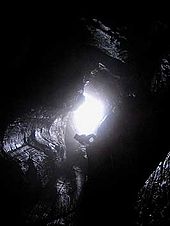Association for Speleology Ebensee
The Ebensee Speleological Association is the second largest speleological association in Austria and is dedicated to the care of the Gassel stalactite cave (show cave ) and the scientific research of caves near the association's headquarters ( Ebensee , Salzkammergut ).
The speleological association today has around 350 members and, according to its statutes, sees itself as a non-political, non-profit association built on a scientific basis.
history
There have been reports on cave research in Ebensee since 1911. The activities took place within the framework of the Ebenseer Bergsteigerbund. So did the exploration of the Gassel stalactite cave from 1918.
The Association for Speleology in Ebensee was not founded until April 8, 1933. The impetus for this was a clause in the lease agreement for the Gassel stalactite cave opened in the same year, in which a sponsoring company was required to operate the show cave. The first chairman was Franz Pergar, who made a significant contribution to the exploration of the cave, the secretary was Hans Falmseder and the treasurer was Franz Ippisch.
The membership was 46 people. In addition to the Gassel cave, cave research was also carried out in the Rötelseehöhle and on the Steinberg. When Pergar resigned from his functions in 1941, Falmseder became the new chairman.
In 1947 after the death of Franz Pergar, the association was reorganized and renamed the "Ebensee Cave Research Association". In the same year, the Gassel stalactite cave was reopened after being closed due to the war.
In 1952, the association finally joined the State Association for Speleology in Upper Austria as the Ebensee section . During this time, people were particularly active in the Hochkogel area and were able to discover and explore some important caves, for example the Plagitzer cave, a stalactite cave in the hanging Kogel.
From 1954 Georg Oberndorfer was chairman, who died in 1961. Franz Novotny became the new chairman. In 1963 the cave was closed due to a lack of staff and the poor visit and could only be reopened in 1973. The number of members has since fallen to 23.

In 1974 the main school director Hubert Heissl became chairman. Research areas were next to the Gassel cave , in which great new territory was found, especially the Dead Mountains , the Höllengebirge and the Dachstein Mountains .
After long negotiations, the association became independent again in 1985 as the Ebensee Cave Association . In 1986, Gerhard Zeppetzauer took over the chairmanship, which he still holds today.
The number of members is around 350 today, with the majority of the members being supportive and making a significant contribution to the preservation of the show cave.
Goals of the association
- Exploration, measurement and documentation of caves, preferably in the vicinity of the association's headquarters, and their scientific research in cooperation with specialist institutions
- Guided tour of the Gassel cave as a show cave and operation of the refuge. Preservation of the pathways in the cave and the preservation of the access path
- Maintenance of nature and monument protection, especially in the area of caves and the rest of the karst treasures
- Dissemination of knowledge about cave and karst forms through publications, lectures or through the organization of conferences
- Training of speleologists and cave guides
- Establishment and training of a cave rescue group in close cooperation with the Association for Cave Rescue in Upper Austria
- Cooperation with other speleological associations and participation in the state cave register
Distribution of caves in the municipality of Ebensee (Salzkammergut, Austria)
To date, more than 200 caves have been discovered and explored in the municipality of Ebensee . The majority is located in the Dead Mountains and the Höllengebirge , which have a high density of caves due to their strongly karstifying rocks ( Wetterstein limestone , main dolomite and Dachstein limestone ).
Some notable cave objects can also be found in the Trauntal Pre-Alps . So the Gasselhöhle , the stalactite cave most of the Northern Limestone Alps . It is located at an altitude of 1229 m at the foot of the Gasselkogel, a branch of the Erlakogel .
literature
- D. Kuffner: 60 years of the Ebensee cave association. - Die Höhle, 44/2, Vienna 1993, p. 34f.

